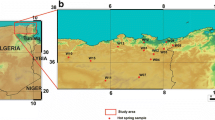Abstract
CO2 is a main component of gases in the Yangbajing geothermal field, usually higher than 85% in volume; others are N2, H02S, H2, CH4, etc. Helium R/Ra ratios, ranging from 0.14 to 0.46, indicate a crustal component to be dominant in the gases. δ13C-CO2 values and δ34 S-H2S values are in the range −7.72‰–−11.33‰ and 0. 2‰–8. 3‰, respectively. The gases are inferred to mostly derive from the partial melting of the Nyainqentanglha core complex. The gases of shallow and deep reservoirs are distinctive in chemical compositions and δ34S-H2S values, which shows their different flowing paths and physical-chemical processes. Sulphur does not approach isotopic equilibrium between H2S and SO-2 4 species in both reservoirs. Significance of steam chemical monitoring is also discussed.
Similar content being viewed by others
References
Zhao Ping, Liao Zhijie, Guo Guoyinget al., Steam quantitative analysis and its implication in the Rehai geothermal field, Tengchong,Chinese Sciences Bulletin, 1996, 41(6): 501.
Giggenbach, W. F., The composition of gases in geothermal and volcanic systems as a function of tectonic setting, inProceedings of the Sewenth International Symposium on Water-Rock Interaction (eds. Kharaka, Y. K., Maest, A. S.), Rotterdam: A. A. Balkema, 1992, 873–878.
Dai Jinxing, Dai Chunsen, Song Yanet al., Geochemical characteristics of natural gases in hot springs of China and their carbon, helium isotopic compositions,Science in China (in Chinese), Ser. B, 1994, 24(4): 426.
Hochstein, W. F., Yang, Z., The Himalayan Geothermal Belt, inTerrestrial Heat Flow and Geothermal Energy in Asia (eds. Gupta, M. L.et al.) New Delhi: Oxford IBH Publishing, 1995, 331–368.
Liang Tingli, Ascending zone of geothermal fluid in northern part of the Yangbajing geothermal field, inProceedings of Tibet (China) Workshop on the Development and Utilization of High-Temprature Ceothermul Resources (in Chinese), Beijing: Geological Publishing House, 1993, 29–32.
Mamyrin, B. A., Tolstikhin, I. N.,Helium Isotope in Nature, Amsterdam: Elsevier, 1984, 273.
Lupton, J. E., Terrestrial inert gases: isotope tracer studies and clues to primordial components in the mantle,Annual Review of Earth and Planetary Science, 1983, 11: 317.
Zhao Ping, Zhang Haizheng, Jin Jianet al., Chemical composition of thermal water in the Yangbajing geothermal field, Tibet,Scientia Geologica Sinica (in Chinese with English abstract). 1998, 33(1): 61.
Fraser, G., Cathy, J. J., James, A. S., Sulphur bank mine, California: An example of a magmatic rather than metamorphic hydrothermal system?, inProceedings of the World Geothermal Congress (eds. Barbier, E., Frye, G.et al.), Florence, 1995, 1105–1110.
Zhao Ping, Armannsson, H., Gas geothermometry in selected Icelandic geothermal fields with comparative examples from Kenya,Geothermics, 1996, 25(3): 307.
Author information
Authors and Affiliations
About this article
Cite this article
Zhao, P., Dor, J., Liang, T. et al. Characteristics of gas geochemistry in Yangbajing geothermal field, Tibet. Chin. Sci. Bull. 43, 1770–1777 (1998). https://doi.org/10.1007/BF02883369
Received:
Issue Date:
DOI: https://doi.org/10.1007/BF02883369




